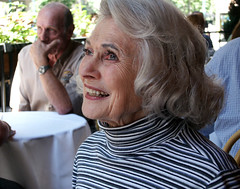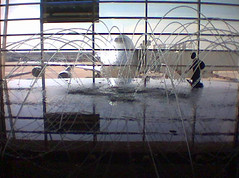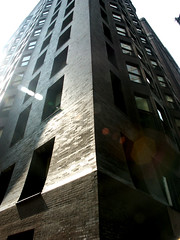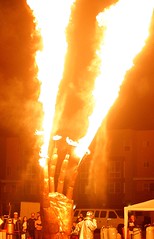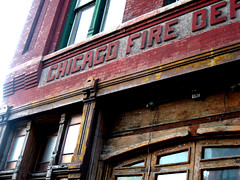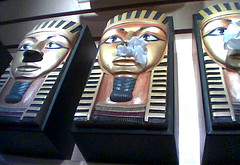a found haiku
I have some bad news
[the one you loved][story here]
s/he did not survive
Monday, July 31, 2006
right now.
right now
would be a good time
for the bombs to stop
for the shells to let up
for the children to sleep
in peace.
right now
would be a good time
for the lacerations
(those still fed
by the warm drone
of a beating heart)
to slowly knit
themselves
together.
would be a good time
for the bombs to stop
for the shells to let up
for the children to sleep
in peace.
right now
would be a good time
for the lacerations
(those still fed
by the warm drone
of a beating heart)
to slowly knit
themselves
together.
Sunday, July 30, 2006
na balam
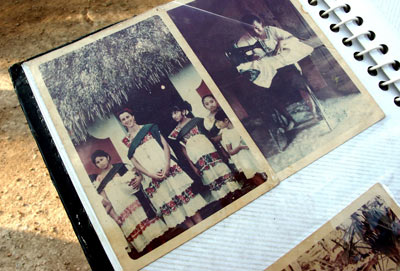
My husband and I were married by two anthropologists, a Mayan shaman, and Lisa Presley.
More about the Shaman and Lisa Presley some other time. Tonight I got the news that my dear anthropologist, and the godmother of my wedding, has died.
Kathryn Josserand was a Mayanist, linguist and epigrapher who taught at Florida State University. She was one of the chief authors of the authoritative Chol dictionary, an indigenous language of the Maya of Central America. She authored countless papers on the subject, and initiated dozens of students in the careful deconstruction – and construction – of Mayan glyphs.
She was brilliant, fiery, highly organized, and the biggest softie this side of the Foster's Freeze. She was Na Balam: The Jaguar. And a real dame.
My husband and I traveled with her and her husband to Guatemala, El Salvador and Mexico countless times. We planned to travel with her again this Christmas, to see some remote Olmec and Zapotec sites.
Today I received an email from her husband Nick with the news that she suffered a massive brain hemorrhage while in the field at Palenque. As unexpected as her death was (she was in her mid-60s) it sounds as though it was a good death – sudden, painless, and well-timed. He wrote, in part:
She went out quickly and painlessly after a good day, feeling great. I thank God we were not in the US, because I was able to be with her from the moment I found her until we wrapped her in her shroud.
In the US I would have been kept in a waiting room, wondering what was going on. In Palenque they don't have the technology to keep the body alive after death; in the US she would have been put on "life" support even though there was no chance of recovery. And in Palenque everybody knew us and I got tremendous support.
The morning after, while I was in town sending out notices, friends came in and set up an altar on Kathryn's work desk, with flowers and candles to call in her soul.***
On Tuesday we had a good day's work, and Kathryn was really happy with what she was getting done. In the late afternoon we went off to look up Moises Morales, whom we hadn't yet visited with. We had a nice long visit, and Kathryn related to him (again) her first trip to Palenque, on a break from her first fieldwork in Yucatan in 1965, with a girlfriend.
The night they were to leave, they were in the Cañada restaurant, and were talking about having to go catch the midnight train for Mérida. A local tour guide heard them and came over to tell them they didn't have to be there at midnight, since the train never came before 2 AM. They went out anyway, and he went to keep them company, and sat with them in the dark telling them about the stars and the Maya.
Years later, when we went back to work in Palenque, she realized this had been Moises Morales, who by then was a central figure in the Palenque Mesa Redonda circle, and who became a good friend of ours. Anyway, Moises was the first Palencano she ever had a long conversation with, and he was the last one.
Kathryn makes an appearance in New Yorker editor Peter Canby’s book The Heart of the Sky: Travels Among the Maya; but it’s late, and I can’t find my copy, and I’d much rather spill some tears into my pillow than look for it any longer.
Maybe tomorrow I’ll get lucky. If I do, I’ll share a few lines here.

people get ready
My paternal grandfather took 10 years to die, and my grandmother nursed him all that while. At the end it was backbreaking work – in addition to a broken ankle that never properly healed, his love of martinis left him with liver disease which would periodically put him in the hospital for long periods of recovery after awful bouts when his system would flood with toxins.
In all those 10 years I never heard my grandmother complain about the work, even though the strain and pain the physical labor caused her (she has severe arthritis in her hands and shoulders) was substantial, and the exhaustion was profound.
I suspect that she thought her husband would live forever that way – and that she would be forever nursing him – and so on one occasion when he was checked into a nursing home for what the doctors prescribed as a prolonged convalescence, my grandmother got a wild hair and decided she would go to Norway.
Within the next few days.
It caused the family some consternation, of course, but I thought it was wonderful -- in large part because I think the impulse to travel is an important one and, when it crops up, must be obeyed – but also because I’d never seen her act out like that, and thought it should be encouraged.
But that’s not to say that I didn’t have some doubts about a 75 year old woman -- who had only traveled once internationally, and then to Japan (as part of a Shriner entourage in the 60s – but that’s a whole different story for a different time) – traveling all alone to a far away place. Fortunately she spoke the language: she was raised by a Norwegian born grandmother and by a mother who, although Chicago-born, preferred Norwegian even when I knew her in her final years.
Grama was leaving in a hurry, so I suggested that I could meet up with her one week into her trip, which would give me time to wrap up some work commitments. That, she said, would be just fine.
So I met her in Stavanger.
It was an extraordinary trip for many reasons, the most remarkable of which was the way that the foreign and yet familiar place triggered stories and songs and memories that she shared with me over the two weeks we looped the country by boat, plane, hydrofoil, car, and train – stories that I had never heard before and haven’t heard since. Stories that were born of her grandmother’s Norway and, surprisingly, stayed behind us when we left it.
There were two moments during the trip that stand in especially high relief. One is of a meal we shared in Oslo. We were early birders, sitting down to dinner at 7 in a city that doesn’t sit down to dinner until 10 during the summer months when the sun carves a huge elliptic out of the sky. It had been a great day and it continued to spill into stories over dinner, and we laughed and lingered long over coffee. (Coffee in Norway is one of those things I could never get enough of. The body of the brew is remarkable – I quizzed dozens of people about the coffee beans they were using – they all looked at me like I was nuts – until a new friend explained to me no, it wasn’t the coffee, it was the water. He had tried with Norwegian coffee and failed to recreate it anywhere else. It was “farské”. Fresh.) (And I'm pretty sure I spelled that wrong.)
She told me stories about her boyfriends (Grama was a beauty: she had many stories to tell.), about meeting my bompa, about the “change” that happened to him when he went away to work one summer in Alaska, with his father, and saw things he shouldn’t have seen. About growing up so poor that when the hot iron scorched her only dress in grade school -- with a big iron mark in the middle -- early in the school year, she was forced to wear it the rest of the school year just like that.
We spent a lot of our time in graveyards over the course of the trip, looking for family plots. She had a few clues to go on, but not much: the only cousin she knew of had passed away some time before. The week she spent in Stavanger without me she used to canvas the phone book – calling all the Ragës within a 50 mile radius, and asking if they were related to so-and-so who passed away who-knew-when.
One afternoon we stopped at an especially beautiful cemetery that was built into a steep hillside. It was a gorgeous afternoon, and the gravestones were decorated, as so many were in Norway, with fresh plantings of blooming flowers. (Frequently we would meet people in these graveyards, who were tending the flowers and shrubbery planted around the stones, the way they would their garden plot at home.)
We had packed a picnic lunch, so we sited a spot on the hilltop as our lunch spot, and headed that way.
Hiking up that hillside, walking through the headstones, scanning for Ragës, I was overcome with the feeling that this dear woman, who raised me in more ways than my own mother did, would die.
At first I tried to escape the feeling. It seemed inappropriate: it was a beautiful day and my grandmother, for all her infirmities, was remarkably strong and hale. It was my grandfather who was dying and, really, I should be thinking of him.
But I couldn’t do any of those things; the knowledge of my grandmother’s mortality was too overwhelming. And I suppose it was accompanied by the knowledge of all that is impermanent, and knowing that I would die too.
So I did what any good Norwegian would do: I said nothing. My grandmother – a tremendously garrulous woman – also said nothing. We hiked the hill in silence, and said only our “pleases” and “thank yous” when it came time to break out the picnic.
We sat largely in silence, eating our lunch, looking out over the sublime Norwegian countryside, and I did my best to hide the fact that I wanted to cry, listening to the refrain that circled through my head: “Remember this. Remember every detail.” It was so apparent, right then, that before too long she would be gone.
It turned out my grandmother was doing the very same thing.
We spoke of it later, in the hotel room, when the emotions had ebbed a bit and we could look back in detachment. She too had been overwhelmed by the very same thoughts at that very moment.
And then a couple years after that picnic lunch a friend of mine asked if my grandmother was available to appear in a regional commercial that she was shooting for a senior care facility; she asked me to appear along with her. (Of course we said yes: Grama was born for the silver screen and had missed her shot when she was younger - the closest she ever came was to work as an usherette in Seattle’s Musicbox Theatre, where she met my grandfather – who yes, was on a date with another woman).
It was a great little ad – I’ve only captured a small clip of it here – but it was edited by a fellow who produces for the Daily Show now, and he cut together a great story. The filming was interview style: The director asked her subjects about getting older. I watched from off-camera as my grama, when asked to share her experience, told the story of the hike up the hill in Norway, and wondering then: where had the time gone? It seemed like just yesterday she was 40, and now -- it’s almost all run out. Unfortunately (for me) my grandmother only appears briefly a few times in the ad. But it’s enough, knowing the story, to bring it all back.
My grandmother turns 87 on Monday. Time is having its way with her. She’s still stunningly beautiful and well preserved, but her memory is slipping, and she frequently finds herself in the kind of mental loops that the elderly slide into: her anxiety is more pronounced, the grievances she holds against those who have wronged her are amplified; the world is a smaller place.
Knowing that I would miss her last few years was the hardest part about deciding to leave Seattle for Chicago; our phone calls, in which I shout and she pretends to hear and then she tells me what she can about what she understands is happening in her life – are small comfort across great distance.
I miss her fiercely, and as more and more of her memory slips away, it becomes more and more difficult to connect with her. And although I know this is the way we die, the way age takes us by increments, it doesn’t make it any easier.
Here’s that clip. And yeah: I have no business posting it, but I stripped out all the brand elements, so let’s see how long it takes YouTube to crack down on me. Grama’s the gal with the silver hair talking about being 75.
During the interview, right after she said “I’m 75” she said “that’s OLD” -- but they cut out that part.
Video: Grama's Debut »
In all those 10 years I never heard my grandmother complain about the work, even though the strain and pain the physical labor caused her (she has severe arthritis in her hands and shoulders) was substantial, and the exhaustion was profound.
I suspect that she thought her husband would live forever that way – and that she would be forever nursing him – and so on one occasion when he was checked into a nursing home for what the doctors prescribed as a prolonged convalescence, my grandmother got a wild hair and decided she would go to Norway.
Within the next few days.
It caused the family some consternation, of course, but I thought it was wonderful -- in large part because I think the impulse to travel is an important one and, when it crops up, must be obeyed – but also because I’d never seen her act out like that, and thought it should be encouraged.
But that’s not to say that I didn’t have some doubts about a 75 year old woman -- who had only traveled once internationally, and then to Japan (as part of a Shriner entourage in the 60s – but that’s a whole different story for a different time) – traveling all alone to a far away place. Fortunately she spoke the language: she was raised by a Norwegian born grandmother and by a mother who, although Chicago-born, preferred Norwegian even when I knew her in her final years.
Grama was leaving in a hurry, so I suggested that I could meet up with her one week into her trip, which would give me time to wrap up some work commitments. That, she said, would be just fine.
So I met her in Stavanger.
It was an extraordinary trip for many reasons, the most remarkable of which was the way that the foreign and yet familiar place triggered stories and songs and memories that she shared with me over the two weeks we looped the country by boat, plane, hydrofoil, car, and train – stories that I had never heard before and haven’t heard since. Stories that were born of her grandmother’s Norway and, surprisingly, stayed behind us when we left it.
There were two moments during the trip that stand in especially high relief. One is of a meal we shared in Oslo. We were early birders, sitting down to dinner at 7 in a city that doesn’t sit down to dinner until 10 during the summer months when the sun carves a huge elliptic out of the sky. It had been a great day and it continued to spill into stories over dinner, and we laughed and lingered long over coffee. (Coffee in Norway is one of those things I could never get enough of. The body of the brew is remarkable – I quizzed dozens of people about the coffee beans they were using – they all looked at me like I was nuts – until a new friend explained to me no, it wasn’t the coffee, it was the water. He had tried with Norwegian coffee and failed to recreate it anywhere else. It was “farské”. Fresh.) (And I'm pretty sure I spelled that wrong.)
She told me stories about her boyfriends (Grama was a beauty: she had many stories to tell.), about meeting my bompa, about the “change” that happened to him when he went away to work one summer in Alaska, with his father, and saw things he shouldn’t have seen. About growing up so poor that when the hot iron scorched her only dress in grade school -- with a big iron mark in the middle -- early in the school year, she was forced to wear it the rest of the school year just like that.
We spent a lot of our time in graveyards over the course of the trip, looking for family plots. She had a few clues to go on, but not much: the only cousin she knew of had passed away some time before. The week she spent in Stavanger without me she used to canvas the phone book – calling all the Ragës within a 50 mile radius, and asking if they were related to so-and-so who passed away who-knew-when.
One afternoon we stopped at an especially beautiful cemetery that was built into a steep hillside. It was a gorgeous afternoon, and the gravestones were decorated, as so many were in Norway, with fresh plantings of blooming flowers. (Frequently we would meet people in these graveyards, who were tending the flowers and shrubbery planted around the stones, the way they would their garden plot at home.)
We had packed a picnic lunch, so we sited a spot on the hilltop as our lunch spot, and headed that way.
Hiking up that hillside, walking through the headstones, scanning for Ragës, I was overcome with the feeling that this dear woman, who raised me in more ways than my own mother did, would die.
At first I tried to escape the feeling. It seemed inappropriate: it was a beautiful day and my grandmother, for all her infirmities, was remarkably strong and hale. It was my grandfather who was dying and, really, I should be thinking of him.
But I couldn’t do any of those things; the knowledge of my grandmother’s mortality was too overwhelming. And I suppose it was accompanied by the knowledge of all that is impermanent, and knowing that I would die too.
So I did what any good Norwegian would do: I said nothing. My grandmother – a tremendously garrulous woman – also said nothing. We hiked the hill in silence, and said only our “pleases” and “thank yous” when it came time to break out the picnic.
We sat largely in silence, eating our lunch, looking out over the sublime Norwegian countryside, and I did my best to hide the fact that I wanted to cry, listening to the refrain that circled through my head: “Remember this. Remember every detail.” It was so apparent, right then, that before too long she would be gone.
It turned out my grandmother was doing the very same thing.
We spoke of it later, in the hotel room, when the emotions had ebbed a bit and we could look back in detachment. She too had been overwhelmed by the very same thoughts at that very moment.
And then a couple years after that picnic lunch a friend of mine asked if my grandmother was available to appear in a regional commercial that she was shooting for a senior care facility; she asked me to appear along with her. (Of course we said yes: Grama was born for the silver screen and had missed her shot when she was younger - the closest she ever came was to work as an usherette in Seattle’s Musicbox Theatre, where she met my grandfather – who yes, was on a date with another woman).
It was a great little ad – I’ve only captured a small clip of it here – but it was edited by a fellow who produces for the Daily Show now, and he cut together a great story. The filming was interview style: The director asked her subjects about getting older. I watched from off-camera as my grama, when asked to share her experience, told the story of the hike up the hill in Norway, and wondering then: where had the time gone? It seemed like just yesterday she was 40, and now -- it’s almost all run out. Unfortunately (for me) my grandmother only appears briefly a few times in the ad. But it’s enough, knowing the story, to bring it all back.
My grandmother turns 87 on Monday. Time is having its way with her. She’s still stunningly beautiful and well preserved, but her memory is slipping, and she frequently finds herself in the kind of mental loops that the elderly slide into: her anxiety is more pronounced, the grievances she holds against those who have wronged her are amplified; the world is a smaller place.
Knowing that I would miss her last few years was the hardest part about deciding to leave Seattle for Chicago; our phone calls, in which I shout and she pretends to hear and then she tells me what she can about what she understands is happening in her life – are small comfort across great distance.
I miss her fiercely, and as more and more of her memory slips away, it becomes more and more difficult to connect with her. And although I know this is the way we die, the way age takes us by increments, it doesn’t make it any easier.
Here’s that clip. And yeah: I have no business posting it, but I stripped out all the brand elements, so let’s see how long it takes YouTube to crack down on me. Grama’s the gal with the silver hair talking about being 75.
During the interview, right after she said “I’m 75” she said “that’s OLD” -- but they cut out that part.
Video: Grama's Debut »
Saturday, July 29, 2006
happy accident

This is my most "faved" shot on Flickr -- the Fave rate is 10%, with 39 faves to 409 views (at this writing). I shot it in low light on a moving train with no flash -- it was a total throwaway at the time. I was riding in an old Burlington Northern Santa Fe train car and was taken with the way the interior was designed and the colors that were used -- I wanted to capture it and take it away with me.
I almost didn't upload it, because of the blur.
This shot is a steady reminder to me that I don't know what I think I know -- I don't know what people will respond to, what they really care about, what really appeals to them -- not precisely.
It's always a crap shoot. Which makes it all the more magical when you throw something out there and it finds a home.
no quarter
Friday, July 28, 2006
krick? krack!
In Haiti, when someone has a story to tell, they shout out to the crowd: “Krick?” – and if the crowd wants to hear what the storyteller has to say they call back: “Krack!”
I’m a glutton for a good story. My favorite kind of story is the one that just appears – inline – walking with a friend from one place to the next; waiting for something, anything; sharing a drink; hanging out on the back patio.
When you tell me a story you tell me not just what happened, but what mattered to you when it all came about. And knowing what matters to you helps me understand the way you see the world you live in. And when it’s a good story, it makes me realize that you and I are not so different, friend. Which makes the world a little bit easier to live in.
This is one of those inline stories: doctorbob@flickr posted a shot of a lyrical green door in Dublin – he called it “The Musical Door” (which is just as good as calling out “Krick?”) I bit – others did too – my comment: “why so musical? does it squeak?” (Krack!). And he replied to the lot of us:
Photo credit, story credit, and full points to doctorbob.
I’m a glutton for a good story. My favorite kind of story is the one that just appears – inline – walking with a friend from one place to the next; waiting for something, anything; sharing a drink; hanging out on the back patio.
When you tell me a story you tell me not just what happened, but what mattered to you when it all came about. And knowing what matters to you helps me understand the way you see the world you live in. And when it’s a good story, it makes me realize that you and I are not so different, friend. Which makes the world a little bit easier to live in.
This is one of those inline stories: doctorbob@flickr posted a shot of a lyrical green door in Dublin – he called it “The Musical Door” (which is just as good as calling out “Krick?”) I bit – others did too – my comment: “why so musical? does it squeak?” (Krack!). And he replied to the lot of us:
@david - thanks for your support :)
@jinmo - love your individuality in your images.
@suttonhoo, are you sitting comfortably?
@jennifer - then, let us begin:
This is the door to an old musical instrument shop in Dublin on one of my favourite streets, Capel Street.
Capel Street is a long Georgian street dating from the last years of the 17th century, the buildings of which have mostly 18th century facades, punctuated here and there by a Victorian pub or a modern office. Nothing is particularly out of place and nothing particularly changed from 250 years ago with the one exception that the street has taken a decidely downmarket air.
In the 18th century it was a fashionable parade with Dukes and Baronesses strolling along and purchasing lottery tickets - wealth was a given and the people inhabiting the street led lives unimaginable to the 'mere Irish' as they were known.
Along this street gentlemen in tailcoats pranced, ladies in plumed hats nodded and servants dashed at their masters whims. Meanwhile 5 miles in any direction from this spot people lived in apalling poverty and suffered some 8 famines in the lead up to the great one of 1845 when one million people died of starvation.
During the passage of the centuries this brilliant avenue began to drift from the raffishness of the lotteries, to gambling clubs and side street inns, gradually a middling crowd took over and the great pubs such as Slatterys appeared and provided a convivial pleasure for real working class Dubliners.
In between grocers, tailors and other merchants plied their wears only really losing ground as the suburbs spread outwards dragging with them the better class of customer in the early 20th century. The revolution, the resultant destruction of the city by British gunships and the catastrophe of the Civil War all played out within an asses roar of the street and pushed the wealth of the area further downwards.
In the 1930s the street was famous for habberdasheries and builders providers as well as furniture. The Emergency as the Second World War is known in Ireland killed off another layer of the small businesses and the street saw the beginnings of some new out of character buildings as planning and design were luxuries that Ireland could ill afford as emmigration sapped the life blood of the nation.
By the 70s the street was reduced to a busy stream of cheap furniture shops, one famous garden shop, an equally famous tailor and some less than salubrious pubs all snarled up in the beginnings of the angry love affair between Hibernia and the car.
Come the 80s stripped pine showrooms with myriad bunkbeds designed to house the baby boom of the early 70s became a common sight and then in the 80s and 90s something mad happened. Sex came to Ireland! Sex shops appeared, protests began, the church ranted, little old ladies railed, rosaries were proffered and yet the sex shops survived - albeit dyslexically - Uthopia (and perhaps they are).
But through it all from the 1920s onwards this little shop sold musical instruments. Fiddles to be loved and played and the soul of the street resided in that brass handle as musicians decades by decade came to view and buy lutes, guitars and all manner of melody makers.
The shop is closed now. That’s why I took the picture.
Photo credit, story credit, and full points to doctorbob.
push me pull you
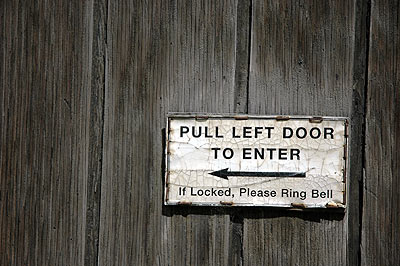
It's a peculiar habit of merchants in the Chicagoland area to leave one of their double doors locked. Always. Almost predictably. Regardless of the season.
I'm sure it has something to do with keeping cold winter winds out, and cold Air Conditioned air in.
I'm also sure it violates some kind of fire code.
You would think this information would be enough to slow me down when exiting or entering a restaurant, a store -- the moment when I grab the door, expecting to swing it hard and wide, or barrel into it, using all my weight to move through.
It isn't. And I'm frequently disappointed to find that I've picked the locked door.
And have bruised myself again.
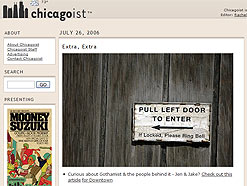 p.s. here's some happy news: this pic made the home page of the Chicagoist yesterday. woo hoo!
p.s. here's some happy news: this pic made the home page of the Chicagoist yesterday. woo hoo!
an eye for color
a found poem
in visual perception
it is necessary to recognize
that color deceives continually
one and the same color
evokes innumerable readings
the aim is to develop
(by trial and error)
an eye for color
seeing color action
feeling color relatedness
just as the knowledge
of acoustics
does not make one musical
what counts here
first and last
is vision
Seeing.
this way of searching
will lead to an awareness
of interdependence
with form and placement
of quantity
quality
and pronouncement
Cobbled together from the Introduction of the Josef Albers classic: Interaction of Color (with liberal editing)
in visual perception
it is necessary to recognize
that color deceives continually
one and the same color
evokes innumerable readings
the aim is to develop
(by trial and error)
an eye for color
seeing color action
feeling color relatedness
just as the knowledge
of acoustics
does not make one musical
what counts here
first and last
is vision
Seeing.
this way of searching
will lead to an awareness
of interdependence
with form and placement
of quantity
quality
and pronouncement
Cobbled together from the Introduction of the Josef Albers classic: Interaction of Color (with liberal editing)
Wednesday, July 26, 2006
cream me
I have tried them all as they came down the pike: dairy-free, fat-free, sugar-free; with tofu, yogurt, rice, whatever.
They always make me sad.
Teacher Linda Calhoun talking about foreign substances pretending to be ice cream.
I’m a fan of butterfat going way back. I swore off margarine early on because I just didn’t trust it. (And it turns out my instincts were spot on.)
It probably had something to do with growing up with an Irish grandfather who buttered the bread of every sandwich he ever ate and poured half and half over his breakfast cereal; a Norwegian grandmother whose own grandmother nursed her when she was ill with draughts of heavy cream (For the nutrients! Only she said that in Norwegian.); and a stepmother from Queens who got the whole food religion in the 70s, and tossed the latkes and matzoh brie of her childhood out the window in favor of tofu and sprouts and homemade granola. (Not entirely true: she still made the occasional potato pancake and cooked up a periodic mess of matzoh brie – and thank god she did, because the granola wasn’t so good.)
I became convinced that I had chosen well when I traveled in Norway and feasted on everything and anything swathed in butterfat -- fish chowders in heavy cream with dots of butter floating on the top, fresh salmon served in a rich cream sauce, the best melkesjokolade I’ve ever had in my life – and looked around me to see a nation full of fit, beautiful, skinny people.
It’s not the food, folks: it’s the portions.
And it’s the fat ass lifestyle that’ll make you or break you. (She says, having moved to Chicago and learned a thing or two about fat ass living her own fine self. Oy vey. Toto: we're not in Boulder anymore.)
So no more trash talk like this please:
The other new method for making super creamy ice cream was caught up last month in the global debate over genetically modified foods.
In June, Unilever, the Anglo-Dutch conglomerate, applied to Britain’s Food Standards Agency for permission to use a new ingredient in its frozen desserts – a protein cloned form the blood of an eel-like Arctic Ocean fish, the ocean pout.
From Creamy, Healthier Ice Cream? What’s the Catch? in today's New York Times
I’m sure it’s fine, I’m sure it’s not fishy, and I’m sure it’s all brilliantly scientific.
But, like Ms. Calhoun, it makes me sad.
lepidoptera dreams
I have often dreamt of a long and exciting career as an obscure curator of lepidoptera in a great museum.
Vladimir Nabokov in an interview in 1964, referring to his scientific passion for butterflies, and quoted today in a story about «The Nabokov Code», an exhibition in St. Petersburg that looks at Nabakov's work in the context of his entymological pursuits.
Should I take comfort -- or despair -- in the thought that even Nabokov wanted to be something else when he grew up?
For what's its worth -- according to the article -- Nabokov worked in his desired capacity at Harvard for awhile, reclassifying the Lycaeides genus, which earned him a mention in the 1951 «Field Guide to the Butterflies of North America».
(Here's a link to the St. Petersburg show -- but heaven knows I wasn't able to get it to load.)
bau-house

Messing around with a new flickr set of random typography shots, and stumbled across this accidental juxtaposition.
"Bau-" was shot at a poster show in Chicago; "House" was shot along Parnell Street in Dublin. (Yeah, I know it's misspelled. But come on -- that's kinda cool.)
Tuesday, July 25, 2006
shifting sands
Two cool unrelated stories about sand dunes in the paper this morning:
Had the scientists listened a little while longer, they may have discovered that the dunes were talking about the weather:
Both bits were in today's New York Times (gotta love that Tuesday Science Times section).
The dunes at Sand Mountain in Nevada sing a note of low C, two octaves below middle C. In the desert of Mar de Dunas in Chile, the dunes sing slightly higher, an F, while the sands of Ghord Lahmar in Morocco are higher yet, a G sharp.Secrets of the Singing Sand Dunes. Clickthrough to the article to hear the audio and find out what they figured out -- but hurry -- the link structure on both of these is thwarting the extended RSS link format -- this link will time out in a few days and only subscribers will be able to access it.
Since at least the time of Marco Polo, desert travelers have heard the songs of the dunes, a loud — up to 115 decibels — deep hum that can last several minutes. ... While the songs are steady in frequency, the dunes do not have perfect pitch. At Sand Mountain, for example, dunes can sing slightly different notes at different times, from B to C sharp.
Had the scientists listened a little while longer, they may have discovered that the dunes were talking about the weather:
If that dune has been fixed in place since ancient times, you can know which way the wind blew back then, and by extension what the climate was like.Shifting Sands and an Ancient Drought
By analyzing the region of dunes known as the Nebraska Sand Hills, scientists at the University of Nebraska have determined that a major wind shift occurred on the Great Plains from 800 to 1,000 years ago. That shift, which brought dry air from the southwest, led to a prolonged drought that was much more severe than the Dust Bowl.
Both bits were in today's New York Times (gotta love that Tuesday Science Times section).
Monday, July 24, 2006
two wheels good

Unlike the horse-drawn carriage, the bicycle was almost silent. It did not crush people to death, nor did it foul the streets with excrement. There were exaggerated complaints about irresponsible velocipedists, but there was also official support for the ‘feedless horse’. Special roads for cyclists were built in France and the United States.
Herlihy mentions the bike path that ran from Prospect Park to Coney Island (‘about 10,000 cyclists participated in the inaugural parade’ in 1885), but not the more spectacular aerial cycle path, opened in 1900, that ran at roof-height for more than nine miles between Los Angeles and Pasadena. Cyclists could ride four abreast on a surface of oregon hardwood, lit by arc lamps every 200 feet. At the halfway point, a bicycle elevator joined the track to the a café, a restaurant and a cascino. Mechanics with pumps and spare parts were positioned all along the track.
From Graham Robb's review of David Herlihy's «Bicycle: The History» in the London Review of Books
Herlihy wasn't the only one who missed that one -- I lived in South Pas and worked in Pasadena for awhile and never heard a word or spotted a remnant of the path Robb writes about. Reminds me of when they outlawed bicycles in Beijing. Where have all the bicycles gone? They were asked to leave.
remodel
Traveling today. Lots of time to think about the little things I would do to make the world a more pleasant place if I had any pull. (I'm feeling cranky too, so watch out.)
Seat people in theatres the way Southwest seats planes – by zone. Middle folks in first. No more of this climbing over my knees 5 min before curtain sh*t.
Take a cue from Japan and activate the indicator light on the elevator as soon as the poor schlep wanting the lift pushes the button. (How courteous and kind is that?) I’m tired of wondering and guessing and then dashing for the door when it finally dings.
If you’re gonna ask me to take my shoes off at airport security, for god’s sake lay down one of those funky paper runners – and change it every day. Nothing icks me out like walking on that airport floor in my socks. And then climbing back into my shoes for a long stinky ride. Ew.
Redesign airplane armrests from the ground up -- replace them with something double-wide and soft and cushy and maybe with a bumper down the middle so I can share it with the big guy in the middle seat without all that unnecessary stranger on stranger arm touching. (More ick.)
Replace all the PA systems remotely associated with public transportation with modern audio components – start with the ones in the terminals and on those old MacDonald-Douglas aircraft – because WE CAN’T UNDERSTAND A WORD YOU’RE SAYING.
When you offer folks an option between two standby flights or one available flight on those quick check-in terminals, flash a warning that you’re flying them into an entirely different airport than you flew them out of. Some of us are just tired and want to get home and WON’T NOTICE that you’re booking us to Midway after we departed from O’Hare. (goddamit.)
not quite clear on the concept
You come here to live like people did in the Middle Ages, but in a four- or five-star hotel.
Rodolfo Lazarich Gener, an economist from Cádiz, quoted in Sunday’s NYT in a piece on the paradores in Spain -- a network of convents, castles and monasteries that were converted to hotels shortly before Franco blew through.
Whadya think the monks liked better: the prix fixe feed or the day spa?
(And whadya wanna bet that Rodolfo wouldn’t have a clue what was going on if someone threatened to “get medieval on his ass”?)
Sunday, July 23, 2006
the unmentionables

I happen to be a pessimist. It’s my nature. I focus on what is UN-heroic and IG-noble in myself and am naturally suspicious of optimists and those who talk about the great things that we Americans are capable of.
I don’t feel like I’ve earned the right to be an optimist – it’s a luxury I can’t afford. Pessimism doesn’t mean defeatism. It just means looking realistically at what we DO, instead of what we like to SAY we do.
And the nice part is, we pessimists are rarely disappointed. Sometimes we’re even pleasantly surprised.
Bruce Norris blogging about «The Unmentionables» as excerpted in «Backstage», Steppenwolf’s house rag.
Norris is three for three with me: Purple Heart, Pain and the Itch, and now The Unmentionables -- all produced at Steppenwolf – all brought it home. (But then I like things dark.)
As they age I suspect they’ll get even better, the way Mamet productions have improved over time, as folks figure out the cadence, music and delivery that makes it juuuuuuuuust right.
(Guess I better take back all those things I said about Steppenwolf, huh?)
fire plug

Last shot after a day of shooting on the near South Side with fellow flickrite p2wy.
Here's a mash up of the day's take aways -- p2 was shooting macro (mostly); I was shooting wide »
Saturday, July 22, 2006
the excellence of every art

The excellence of every art must consist in the complete accomplishment of its purpose.
Another one of the beautiful old Arts & Crafts buildings that line Printers Row in Chicago. (I'm not sure I understand what it means -- or agree -- but I'm digging that tilework.)
what we have done
a found poem
my mother has started cutting necks
my grandmother kneels beside her
between them is a pile of chicken heads
wall-eyed, astonished
the stunned crop of white feathers
against the pink wavy flesh
of fading combs
my oldest sister
snar[es] chickens
with a long wire legcatcher
[she] is god today
my second-oldest sister
retriev[es] chickens
from the headless places they have flown to
vivid sprays [of] blood
rising in fountains on the white stucco walls
bucking up against the trunks of cottonwoods
soak[ing] patches in the grass
the red-iron smell
strewn across the dewy green lawn
my grandmother
holds her hand around the chicken’s neck
tilting it like a wine bottle
she means to pour down to nothing
the water is boiling in tubs
the feathers come off in clumps
the smell is complex
water meets wool meets vinegar meets dirt
like wet fur, like bad feet
“Mmm, girls, just think,” she says: “fresh chicken.”
we walk the red wheelbarrow
to the dump ground
to bury the parts
metallic tinge of blood
still in my mouth
(do I have to?)
I must.
I must learn to know the taste
of what my hands have done
on my tongue
Thanks and apologies to Debra Marquary, who wrote the original really lovely piece (chock full of blood and manure) «Chores: An endless stream of tasks to keep you from having fun», just published in the July | August 2006 edition of Orion.
my mother has started cutting necks
my grandmother kneels beside her
between them is a pile of chicken heads
wall-eyed, astonished
the stunned crop of white feathers
against the pink wavy flesh
of fading combs
my oldest sister
snar[es] chickens
with a long wire legcatcher
[she] is god today
my second-oldest sister
retriev[es] chickens
from the headless places they have flown to
vivid sprays [of] blood
rising in fountains on the white stucco walls
bucking up against the trunks of cottonwoods
soak[ing] patches in the grass
the red-iron smell
strewn across the dewy green lawn
my grandmother
holds her hand around the chicken’s neck
tilting it like a wine bottle
she means to pour down to nothing
the water is boiling in tubs
the feathers come off in clumps
the smell is complex
water meets wool meets vinegar meets dirt
like wet fur, like bad feet
“Mmm, girls, just think,” she says: “fresh chicken.”
we walk the red wheelbarrow
to the dump ground
to bury the parts
metallic tinge of blood
still in my mouth
(do I have to?)
I must.
I must learn to know the taste
of what my hands have done
on my tongue
Thanks and apologies to Debra Marquary, who wrote the original really lovely piece (chock full of blood and manure) «Chores: An endless stream of tasks to keep you from having fun», just published in the July | August 2006 edition of Orion.
egyptian revivialismsionism

This batch is for my little brother (am I allowed to call you that after you’ve cleared 30, AMB?), who lobbed me an email after the Dawes post and said that, actually, he *would* like to hear more about that Egyptian Revivalism tour.
Problem is, I wish I had more to tell. We saw a smattering of buildings and a huge outcropping of mausoleums scattered around the city and in various cemeteries, the majority of which were built during a surge in interest in all things Egyptian between 1880 and the turn of the century.
There were two disturbing trends in evidence – both of them with the same roots – the diminishment of “paganism” overtime – making Egyptian iconography safe by throwing in a Judeo-Christian angel or two – and the curious emergence of Anglo-features on the figures that had faces – Reebie’s Seti and Schoenhofen’s Sphinx were the two most obvious examples that we came across.
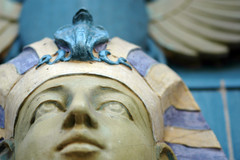

I wish I knew more about 1) what awakened the interest in this round of development (there were some big archaeological finds -- although Tut wouldn't be uncovered for nearly half a century -- but was it also connected to the Spiritualism that thrived during this time?) and 2) whether the presence of this stuff in the city of Chicago had any influence on the thing that AMB’s working through in his thesis – SunRa’s whole crazy trip.
But I don’t. And it’s late. So no research tonight. Just the pictures I promised, and this little tidbit: There are two Seti statues flanking the front door of Reebie Moving and Storage (their ad slogan: "If Old King Tut were alive today, he'd store his things the Reebie way"). The base that they stand on is inscribed with actual hieroglyphs that read:
Protect your furniture • I work for all your reigns in sunshine and darkness forever • Behold the cargo swiftly sent up the Nile in the time of the Pharohs
So you see, there are some advantages to traveling in the company of Egyptologists.
So here you go, little bro: Here's your Egyptian Revivalism Architecture in Chicago Slideshow »
Friday, July 21, 2006
Thursday, July 20, 2006
visual literacy
In a new memoir, “Let Me Finish,” Roger Angell recalls trips to the Polo Grounds and Yankee Stadium in the 1930’s with his father, who also liked to join pickup games when middle-age American men still did that.
Today baseball is like the arts, with grown-ups mostly preferring not to break a sweat. “We know everything about the game now, thanks to instant replay and computerized stats, and what we seem to have concluded is that almost none of us are good enough to play it,” Mr. Angell writes.
So it is with classical music, painting and drawing, professional renditions of which are now so widely available that most people probably can’t or don’t imagine there’s any point in bothering to do these things themselves. Communities of amateurs still thrive, but they are self-selecting groups. A vast majority of society seems to presume that culture is something specialists produce.***
We have given it up, at a cost that, as Franklin might have put it, is beyond words. Mr. Angell goes on in his book to say that television and sports journalism have taught us all about the skills and salaries and private lives of professional ballplayers, on whom we now focus, instead of playing the game ourselves.
As a consequence, he writes, “we don’t like them as much as we once did, and we don’t like ourselves much, either.”
Michael Kimmelman writing about «Teaching America to Draw», an exhibition at the Grolier Club, in « An Exhibition About Drawing Conjures a Time When Amateurs Roamed the Earth» in Wednesday’s New York Times.
Kimmelman has a point, but I think too that he needs to spend a little time online to see the amateurism that’s flowering around him – on places like blogger and typepad and youtube and flickr. The tools have changed, but the impulse to “preserve a cherished sight, a memory” and tell a story remains the same.
Although I’m with him on his central point: it sucks that so few of us can draw – can really illustrate – any more. We’ve lost an important form of literacy – and there’s no reason to believe that we’ll be able to, or even attempt to, restore it.
the wild parakeets of hyde park

What you would see -- if I had actually hit the “record video” slider on my little PowerShot the way I thought I had -- what you’d be looking at here is lousy video of wild parakeets.
But instead what you get is a fraction of the first frame in which a goof stood, holding a camera over her head (a camera that was recording NOTHING) while she watched three wild parakeets moving through the tree, rustling the leaves and fluttering from branch to branch – there appeared to be two nests in there too. You’d also hear some stupid chatter – laughter, oohing, ahhing, “there he is!” sorts of things, so maybe it’s a good thing that I blew it with the video.
The video-of-wild-parakeets-that-wasn't was (not) recorded in Chicago’s Hyde Park -- where the parakeets live year round.
Have you ever spent a winter in Chicago? It’s no Telegraph Hill. These are birds with some serious character.
Wednesday, July 19, 2006
lake effect
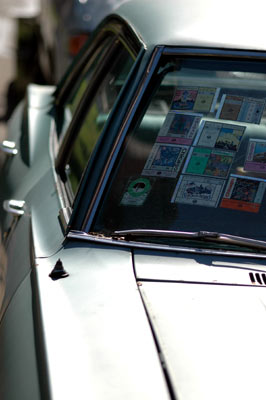
Here’s a fun trick: The next time you find yourself in a small-ish gathering of Chicagoans or long time Chicagoland-residents, ask them where the Lake is.
Then, like needles on a compass, watch them spin and point in an Easterly direction – with unerring accuracy and a beautiful, almost eerie, synchronicity – all the while looking at you with that strange mixture of pity and disgust that Midwesterners reserve for people without any common sense.
I’m probably the only one in the room who finds this fascinating, but it never fails to amuse and amaze me. It could be because, growing up for a good while in Denver, my polestar was to the West – and it’s hard to miss the Rocky Mountains.
But this is Lake Michigan we’re talking about – it’s FLAT. You can’t see it from anywhere except the lakeshore. And being able to pick it out of the grid – regardless of where you are in the Chicagoland area – is the hallmark of true residency.
I’m not there yet. I still haven’t experienced that polar shift.
If it does happen I suspect it’ll come on suddenly, the same way the tectonic plates shifted on the Eisenhower when that minivan crashed into my lane without signaling or allowing decent clearance.
Without thinking I did the thing that no one in my family (we're not from these parts) would believe or understand: I leaned long and hard on the horn and issued a steady and violent stream of obscenities that generously and sufficiently described the driving and mating habits of the thoughtless wonder behind the wheel – all the while looking at her with that same strange mixture of pity and disgust.
Just like a Chicagoan.
flickr is not a truck.
I’m not going to write about how Flickr was down tonight. Because everybody else did. (That's just an excerpt below -- here's a better sample.)


Daily traffic rank trend graph courtesy of Alexa.org »


Daily traffic rank trend graph courtesy of Alexa.org »
dawes tomb

Passed by Charles Gates Dawes' tomb on Saturday's pitstop at Rosehill Cemetery during the Egyptian Revival Tour (oh you REALLY don't want to hear about ALL the egyptian revival mausoleums we looked at in that unbearable heat -- do you?). A history fan had dropped by -- probably over the 4th of July holiday -- and festooned the doors with flags.
Led me to research what he was all about -- Vice President under Coolidge he picked up the Nobel Peace Prize in 1925 for his work on the Dawes Plan -- an effort to ease the pain of German reparations. Apparently it didn't pan out so well, as WWII would soon prove.
Of course I took a wrong turn while researching and dusted off the Dawes Act. Kinda wish I hadn't. Seems whenever we get around to imposing our American Way we manage to bung it up somehow.
Here's an excerpt from Wikipedia (in dispute of course -- because it's an unpleasant notion) about the Act put forward by another Dawes, this one a senator from Mass:
The Act had one of the most substantial impacts on Natives, most significantly affecting Native gender roles. This Act broke up the reservation lands into privately owned parcels of property. In this way, the legislators hoped to complete the assimilation process by deteriorating the communal life-style of the Native societies and impose values of strengthening the nuclear family and values of economic dependency strictly within this small household.
Legislators' opinions of communal living saw the extended family as “needy” since the Indigenous ideas of wealth contrasted and disagreed with Western ideas of wealth (Stremlau 277). Indigenous people valued generosity and received status by being generous. Western values form around individual wealth and surplus and status is gained from these same values.***
The Act forced Native people onto small tracts of land distant from their kin relations. Traditionally, in most Indigenous societies, women were the agriculturists while the men were the hunters and warriors. The Allotment policy depleted the land base, ending hunting as a means of subsistence. According to Victorian ideals, the men were forced into the fields to take on the woman's role and the women were domesticated.
This Act imposed a patrilineal nuclear household onto many traditional matrilineal Native societies. Native gender roles and relations quickly changed with this policy since communal living shaped the social order of Native communities. Women were no longer the caretakers of the land and they were no longer valued in the public political sphere. Even in the home, the Native woman was dependent on her husband.
Before Allotment, women divorced easily and had important political and social status for they were usually the center of their kin network (Olund 157). With this Act, women were deprived title to land and the distribution of allotments proves this point. To receive the full 160 acres, women had to be married and even then, her husband received title to the land.
Here's a link to the whole act, if you're curious »
Tuesday, July 18, 2006
torch it
Some girls dream of their wedding dress. I dream of the dress I'll be wearing the night I climb on top of a grand piano in some smokey jazz club and start belting out standards and torch songs.
You think I’m kidding. I have my list:
Night & Day
Summertime
Blue Skies
A kiss to build a dream on
They can’t take that away from me
I won’t dance (you can’t make me)
Sinnerman
That’s the warm up.
Which is of course why I cajoled litwit into a Monday night out to see a girl singer that neither one of us had ever even heard before – except one of us, briefly, in a Henry Jaglom film a long, long, time ago.
But the Algonquin, where Andrea Marcovicci performs a generous share of her winter months, lends her some serious cabaret cred, so I figured we couldn’t miss.
Well. We did. Sorta.
I suppose she pulled it out in the end, and left us with some really charming moments, but as litwit writes up beautifully, she stumbled considerably in the beginning -- with some funky phrasing, curious high notes mixed in with a whole lot of Rex Harrison-talkie-like thingys -- and an all around general lack of dame-ness – the one quality that a girl singer has gots to have if she’s gonna make it happen.
It was the kind of show my grandmother would have loved – sentimental songs from the 30s and 40s – although I suspect she would have said, under her breath (or at least thinking it was -- the poor dear is awfully deaf) as we exited the theater: “it was lovely to hear the old songs: but we didn’t exactly sing them like that.”
(Much the same way she whispered, overloud, as we exited the Troldhaugen Concert Hall in Oslo after a round of – well, of course -- Grieg choral pieces: “that was a lovely. But did they have to sing all those beautiful songs in Russian?” An understandable grievance. She’d waited a long time and came a great distance to hear some Norwegian in Norway. And I suspect she was still holding a grudge against the Russians for the Cold War, the same way she’s still holding a grudge against the Swedes for the way they let the Germans just march right through during WWII. But all good Norwegians do.)
But I shouldn't be so hard Marcovocci -- there were some genuine lovely bits in the evening -- she's a marvellous storyteller and had moved through the awkwardness by just about the halfway point -- and I did come away with one more song for my list that is almost as remarkable for its provenance as it is for its smoldering wonderfulness – Kurt Weil and Ogden Nash? Collaborators? For Marlene Dietrich? Who knew?
And there's the dress.
You think I’m kidding. I have my list:
Night & Day
Summertime
Blue Skies
A kiss to build a dream on
They can’t take that away from me
I won’t dance (you can’t make me)
Sinnerman
That’s the warm up.
Which is of course why I cajoled litwit into a Monday night out to see a girl singer that neither one of us had ever even heard before – except one of us, briefly, in a Henry Jaglom film a long, long, time ago.
But the Algonquin, where Andrea Marcovicci performs a generous share of her winter months, lends her some serious cabaret cred, so I figured we couldn’t miss.
Well. We did. Sorta.
I suppose she pulled it out in the end, and left us with some really charming moments, but as litwit writes up beautifully, she stumbled considerably in the beginning -- with some funky phrasing, curious high notes mixed in with a whole lot of Rex Harrison-talkie-like thingys -- and an all around general lack of dame-ness – the one quality that a girl singer has gots to have if she’s gonna make it happen.
It was the kind of show my grandmother would have loved – sentimental songs from the 30s and 40s – although I suspect she would have said, under her breath (or at least thinking it was -- the poor dear is awfully deaf) as we exited the theater: “it was lovely to hear the old songs: but we didn’t exactly sing them like that.”
(Much the same way she whispered, overloud, as we exited the Troldhaugen Concert Hall in Oslo after a round of – well, of course -- Grieg choral pieces: “that was a lovely. But did they have to sing all those beautiful songs in Russian?” An understandable grievance. She’d waited a long time and came a great distance to hear some Norwegian in Norway. And I suspect she was still holding a grudge against the Russians for the Cold War, the same way she’s still holding a grudge against the Swedes for the way they let the Germans just march right through during WWII. But all good Norwegians do.)
But I shouldn't be so hard Marcovocci -- there were some genuine lovely bits in the evening -- she's a marvellous storyteller and had moved through the awkwardness by just about the halfway point -- and I did come away with one more song for my list that is almost as remarkable for its provenance as it is for its smoldering wonderfulness – Kurt Weil and Ogden Nash? Collaborators? For Marlene Dietrich? Who knew?
Speak LowSo there's that.
Speak low when you speak, love
Our summer day withers away too soon, too soon
Speak low when you speak, love
Our moment is swift, like ships adrift, we're swept apart, too soon
Speak low, darling, speak low
Love is a spark, lost in the dark too soon, too soon
I feel wherever I go that tomorrow is near, tomorrow is here and always too soon
Time is so old and love so brief
Love is pure gold and time a thief
We're late, darling, we're late
The curtain descends, ev'rything ends too soon, too soon
I wait, darling, I wait
Will you speak low to me, speak love to me and soon
And there's the dress.
Monday, July 17, 2006
monadnockhamen
Here's something that maybe you didn't know about the Monadnock Building, Burnham and Root's gorgeous 16-story brick skyscraper in Chicago's downtown Loop -- considered by most CAF docents to be the first skyscraper. Ever. Which meant it was also the tallest -- if only just for a brief while after it was erected between 1889 and 1891.
The spare lines of the Monadnock -- which rise off of 6 foot thick masonry walls which flare at the base and are frequently praised as a harbinger of Modernism -- almost weren't. (Spare, I mean.)
Burnham dolled up the original architectural plans with crazy Egyptian Revivial ornamentation. Then he went on vacation. And while he was away Root stripped the papyrus inspired cornice off the top of the building, and all the frills that came along with it.
My source: Michael Berger, Egyptologist and knowledgable guide on this weekend's tour of Egyptian Revival architecture in Chicago. (I know, I know: I keep doing this Tut thing to myself. Somebody stop me. Please.)
Rumor has it that Burnham was pretty pissed when he got back. But he eventually cooled off. And the Monadnock pretty much impressed the pants off everyone who cared about these things, and continues to do so today.
And you've gotta admit it's the most huggable skyscraper you've ever seen. (You're laughing -- but have you ever stepped right up to it? You'll wannna hug it. I promise.)

The spare lines of the Monadnock -- which rise off of 6 foot thick masonry walls which flare at the base and are frequently praised as a harbinger of Modernism -- almost weren't. (Spare, I mean.)
Burnham dolled up the original architectural plans with crazy Egyptian Revivial ornamentation. Then he went on vacation. And while he was away Root stripped the papyrus inspired cornice off the top of the building, and all the frills that came along with it.
My source: Michael Berger, Egyptologist and knowledgable guide on this weekend's tour of Egyptian Revival architecture in Chicago. (I know, I know: I keep doing this Tut thing to myself. Somebody stop me. Please.)
Rumor has it that Burnham was pretty pissed when he got back. But he eventually cooled off. And the Monadnock pretty much impressed the pants off everyone who cared about these things, and continues to do so today.
And you've gotta admit it's the most huggable skyscraper you've ever seen. (You're laughing -- but have you ever stepped right up to it? You'll wannna hug it. I promise.)

too darn hot
These are the days of talc and lemonade.
As forecast by Gaper's Block:
They forgot to mention the 90% humidity.
oy vey.
(hey cool [she says, having browsed to gaper's block to pick up the weather report] -- one of my pics made Rearview. woo hoo!)

As forecast by Gaper's Block:
THE HEAT IS ON
High: 92F, Low: 71F
They forgot to mention the 90% humidity.
oy vey.
(hey cool [she says, having browsed to gaper's block to pick up the weather report] -- one of my pics made Rearview. woo hoo!)

hang it up
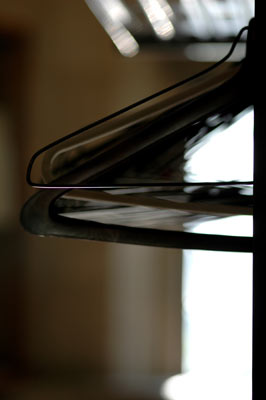 I have an unnatural fear of clothes hangers in a state of repose (goes back to an unhappy incident when I was a kid and hooked my foot on a hanger that was lying on the floor when I was pulling off a pair of jeans -- I pulled the hook end of the hanger up my leg and cut a deep and narrow and painful gash).
I have an unnatural fear of clothes hangers in a state of repose (goes back to an unhappy incident when I was a kid and hooked my foot on a hanger that was lying on the floor when I was pulling off a pair of jeans -- I pulled the hook end of the hanger up my leg and cut a deep and narrow and painful gash).But I thought these were strangely beautiful.
Shot at the Oriental Institute -- a brilliant little museum on the University of Chicago campus. They call themselves the "best kept secret in Chicago". I suspect if they would just change their name (it's so pre-Said) they would get more traffic.
But then you'd lose all that great history...
Sunday, July 16, 2006
how do you solve a problem like kohlrabi?

I got lucky with my hubby: We share many of the same inclinations when it comes to architecture, archaeology, theology, politics, and how to make the best use of nap time.
But we don’t eat eye-to-eye.
I was raised a hippie and love the whole foods; he was raised Nebraskan and loves his meat and potatoes.
Friends who knew something about the way I used to cook before I moved to the Midwest (lamb tagine with meyer lemons and kalamatas; fresh oysters served with horseradish and Tabasco alongside home-seasoned sausage patties and a crisp green salad [try it: you’ll be amazed]; roasted tomatoes stuffed with basil, garlic, bread crumbs and anchovies and served over cold rice; odd concoctions with swiss chard; anything with arugula) would be surprised to see the compromises I arrive at now in an effort to keep everyone happy: Meals like free-range turkey brats with fresh-off-the-cob creamed corn (yep: I’m not making this up), and anything that incorporates the holy veggie trinity of Midwestern cuisine: corn, potatoes and beans. (Salade Niçoise accommodates the combo pretty well.)
Enter the Green Earth Institute. We signed up this year for a CSA subscription – that means that we pay a flat fee at the beginning of the summer and every couple of weeks we pick up a big bushel of veggies.
The selection of which we have no say in whatsoever.
But they’re always fresh and just this side of amazing.
I love the surprise part of the equation. But it introduces some challenges – because not once yet this summer have corn or beans been in the mix. Sugar peas so sweet you could eat ‘em like candy have been in the bag; but no beans.
And the last couple of weeks, kohlrabi has been waiting for us.
This veggie is entirely new to me. It’s not really a root vegetable – it grows above ground and looks like the lovechild of a cabbage and a turnip. And I don’t know about you, but I didn’t know WHAT the hell to do with it.
Googling recipes was fruitless. Lotta sautéed in butter or mustard recipes that would make more sense in wintertime. My favorite online standbys – the Saveur and Epicurious recipe databases – came up mostly empty on the subject of kohlrabi (unless I felt like german-style stuffed kohlrabi. I didn't. Still don't.)
So I had to take matters into my own hands. Inspiration struck last week when I pulled out a recipe that had run the Sunday before in the NYT Magazine and had all the makings of Midwestern contentment: Clementine’s Tuna-Macaroni Salad. (The things a girl will do for love.) But when I got around to making it I realized I was missing celery and scallions – and the idea of a glutinous mass of mayo slathered macaroni with tuna and cheese and not a crispy, spicy bit in sight really got me down.
In kohlrabi lay my celery salvation. Diced up nice and tiny it's all crispy with just a little bit of heat. And for scallions: I substituted this funky curly flowery spur that’s trimmed off of garlic before it comes into its own. (Pic provided below for edification – but don’t even ask me to tell you what it’s called. It was in the CSA bag. That's all I know.)
Here’s the NYT’s recipe – I’ve struck out ingredients and penciled in my own where I made substitutions.
Clementine's Tuna-Macaroni SaladSalt 1/2 pound uncooked elbow macaronipenne pasta1/2 cup 1/4 -inch diced celerykohlrabi2 ounces sharp Cheddar, cut into 1/4 -inch cubes (I used coarsely shredded parmesan because I had some around) 1/4 cup thinly sliced scallionsfunky garlic-y thing-y1/4 cup sliced cornichon rounds 2 tablespoons mild Tennessee chow chow (optional)didn’t happen1 cup mayonnaise (happily got away with about half that much) 2 6-ounce cans chunk light tuna in water, drained Freshly ground black pepper to taste
1. Bring a large pot of salted water to a boil. Add the macaroni and cook. Drain and cool completely.
2. In a large bowl, fold together the macaroni with the remaining ingredients.
Season.
Serves 6. Adapted from Clementine in Los Angeles.
Note: Chow chow is available at http://ecommerce.lcs.net/stores/whites/
Figured out another application for kohlrabi tonight, when I just didn’t feel like making anything interesting (90 degrees w/ 90% humidity always brings out the slug in me) so I pulled out some frozen buffalo patties and cooked up a couple of burgers: It makes a nice substitute for an onion slice. Kind of a funky, crunchy jicama and radish hybrid.

light my fire
First b1-66er posted some amazing low-res shots this morning that were all mystery and fire and light. (You might need to scroll a bit once you hit his home page.)
[update: b1-66er has posted a write up of the event -- definitely worth the read »]
Then I got this email from a friend:
Then I hit Flickr, figuring if anyone else was there it would be Thomas Hawk. Well: almost. He got his last year, in 2005. Check out his chronicle of (last year's) event »
Being there would have been better, but baby, sometimes the story's all you've got.
[Photo credit: Thomas Hawk]
[update: b1-66er has posted a write up of the event -- definitely worth the read »]
Then I got this email from a friend:
Went to the Crucible's Fire Arts festival. It is an art school in Oakland that teaches art that is related to fire. Blacksmithing, goldsmithing, glassblowing, neon art, etc. Once a year they have a festival with fire arts performers. It was spectacular to say the least.
A lot of Survival research labortories type robotic sculptures, devices that spewed fire, sometimes colored fire, sometimes inches, sometimes many feet into the air. They had a dance video machine set up where you competed with someone else, but they put you in a fireproof suit and they blasted you in the face with a flamethrower if you made a mistake.
A couple guys had some fans set up. They were wearing fireproof suits and were armed with flamethrowers. They were making a fire tornado that at times would get to be 30 to 40 feet in the air. Very impressive.
Then I hit Flickr, figuring if anyone else was there it would be Thomas Hawk. Well: almost. He got his last year, in 2005. Check out his chronicle of (last year's) event »
Being there would have been better, but baby, sometimes the story's all you've got.
[Photo credit: Thomas Hawk]
apple, sisu & mangosteens
“Sisu,” [a Finnish word] which denotes a grim determination to do what must be done, regardless of circumstances.
Came across this word in a travel piece on Helsinki in the Sunday paper. I dipped into the article not because I’m interested in going to Helsinki, but because there was the promise of learning something about Finnish architecture, and indeed I did (more about that later), but I kept reading it because mid-way into the piece I came across a passage that made me wonder “who is this wonderful writer?” and, looking at the by-line for the first time, I realized it was my favorite living food writer (MFK gets the dead accolade): RW Apple, Jr.
Apple is, of course, more than that – he’s also an associate editor of the NYT which makes him an all around big-shot – but I love him most for writing things like this:
The Savoy, founded in 1937 and designed by Aalto, is Helsinki’s much lower-key counterpart to Manhattan’s Four Seasons, founded in 1959 and designed by Mies and Philip Johnson – playpen of the powerful, defender of the local culinary faith, temple of classic form.
Perched on the eighth floor of an office building, amid the Esplanade treetops, it is furnished with chairs, light fixtures and even coat racks by the master and filled with his trademark free-form vases, whose shape is echoed in a serving table.
This was the favorite restaurant of Finland’s national hero, Marshall C.G.E. Mannerheim, and his favorite dish, vorschmack, a mixture of ground beef, mutton and minced herring, is always on the menu.
Too folkloric for me, I’m afraid, and I confess that I wasn’t thrilled to see an “orange tart with Sri Lankan cinnamon foam” on the menu recently. Catalonia has a lot to answer for. But there are always lots of things Betsey and I love to eat in this ever-fresh setting, with bright blue and white pansies in its window boxes: white asparagus in season, partridge mousse, grilled herrings with dill butter, pike perche with horseradish butter and salmon with creamed morels (game and wild mushrooms from the all but limitless forests are Finnish passions, and on June 20, the first day of wild duck season, you’ll find the duck on many restaurants’ menus).
See how much you know about Finland now? About its restaurants, historical cuisine, architecture, national heros, Catalonian influences, passions, limitless forests, general atmosphere, and – good lord – duck hunting season.
And only two paragraphs later. Unbelievable. And he spoons it out so deliciously: You take it in like ice cream.
Still not convinced? Read RW Apple Jr on Mangosteens. That should make a believer out of you. (I ache for mangosteens – and I’ve never had one in my life. That’s what makes Apple my favorite food writer.)
So I promised you a morsel on Finnish architecture. Here it is, with a very sweet association with Chicago architecture:
Consider Eliel Saarinen’s Helsinki train station (1919), with its four forbidding stone guardians, strange and giant figures bearing illuminated globes, straight from Nordic myth.
It led to Saarinen’s entry for the Chicago Tribune Tower competition in 1922, in which he finished second, and that in turn led to his appointment to head the Cranbrook Academy of Art, near Detroit.
There he trained a whole generation of quintessentially American designers, including Florence Schust Knoll, Harry Bertoia, Ray and Charles Eames and his own illustrious son, Eero, the creator of such soaring, optimistic structures as the Gateway Arch in St. Louis and Dulles airport near Washington.
From RW Apple Jr's «Helsinki's Shining Season» in this Sunday's New York Times.
Hmm. Eames, eh? And the St. Louis Arch? Maybe I should think about checking out Helsinki after all.
painting pigeons at the tate
a found poem
it’s elephant time
for our cherry tree
a flock of starlings
black, glossy, speckled
land and scramble
among the leaves
a pair of wood pigeons
soft grey backs
pink-pug breasts
white collars
land and cling unsteadily
they reach for cherries
which they swallow whole
it is late one a warm afternoon
we watch the birds
strong green and black
patterned with splodges of cherry red
pigeon-breast pink
pigeon-wing grey
speckled slab of starling-wing black
small, pigeon-collar comma of white
the pleasure
which is considerable
in flowers
feathers
lichens
minerals
sunsets
the brilliant green of a pool of stagnant water
a stain left by rust
the grey veil of distant rain
and in fabrics
and works of art
The rules of the game remain the same: No resequencing, only deletions, and an occasional [insertion] (but none here today).
Thanks and apologies to Peter Campbell who wrote the original piece, a highly enjoyable review of Howard Hodgkin’s show «At Tate Britain» in the 6 July edition of the London Review of Books.
it’s elephant time
for our cherry tree
a flock of starlings
black, glossy, speckled
land and scramble
among the leaves
a pair of wood pigeons
soft grey backs
pink-pug breasts
white collars
land and cling unsteadily
they reach for cherries
which they swallow whole
it is late one a warm afternoon
we watch the birds
strong green and black
patterned with splodges of cherry red
pigeon-breast pink
pigeon-wing grey
speckled slab of starling-wing black
small, pigeon-collar comma of white
the pleasure
which is considerable
in flowers
feathers
lichens
minerals
sunsets
the brilliant green of a pool of stagnant water
a stain left by rust
the grey veil of distant rain
and in fabrics
and works of art
The rules of the game remain the same: No resequencing, only deletions, and an occasional [insertion] (but none here today).
Thanks and apologies to Peter Campbell who wrote the original piece, a highly enjoyable review of Howard Hodgkin’s show «At Tate Britain» in the 6 July edition of the London Review of Books.
have a seat
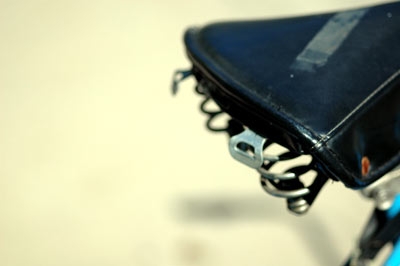 When I spotted this Schwinn on the University of Chicago campus, I thought I had spotted a rare treasure. Walking around the neighborhood later I realized it was the bike of choice for grad students who had stayed through the summer session. Battered old Schwinn's were a dime a dozen.
When I spotted this Schwinn on the University of Chicago campus, I thought I had spotted a rare treasure. Walking around the neighborhood later I realized it was the bike of choice for grad students who had stayed through the summer session. Battered old Schwinn's were a dime a dozen.But that didn't make them any less lovely.
Hyde Park, Chicago IL
Here's the whole (brief) Schwinn set »
Saturday, July 15, 2006
awkward silence
I never know whether to be flattered or insulted when someone repeats back to me -- as if it was their original idea -- something that I've said before to them.
Clearly they thought it was clever enough to appropriate; but I suspect -- if they're giving it back to me as though it's the first time I've heard it -- that they don't think I'm clever enough to have thought of it.
Clearly they thought it was clever enough to appropriate; but I suspect -- if they're giving it back to me as though it's the first time I've heard it -- that they don't think I'm clever enough to have thought of it.
home of engine #42
Just got a gem of an email from obtr32@flickr (aka Pauly) who dropped me a line a few weeks back after one of my Chicago Firehouse pics ran on the WBEZ home page (part of a larger set of a really lovely, albeit dilapidated, structure in Chicago's River North neighborhood).
He told me that he was reading a book on Chicago Firehouses and thought he might be able to find some more details about the structure.
He did.
Here's his email:
In a follow up email Pauly sent a pic from a Flickr’er who identifies the firehouse as the set for McGinty's Bar in the television show Early Edition that ran for a few short years from 1996 to 2000.
And that’s only ONE of the reasons that I love Flickr. (Thanks, Pauly!)
He told me that he was reading a book on Chicago Firehouses and thought he might be able to find some more details about the structure.
He did.
Here's his email:
I GOT YOUR CHICAGO FIRE HOUSE.
It took me a while because it is actually 228 W. Illinois street. I was looking for a Franklin address.
Your firehouse was built in 1888. Home of Engine #42- Squad #1- Salvage squad #1. It ran for 80 years (1888 to 1968).
In 1964, Engine #42 had to be relocated to 202 E. Chicago for a short period of time due to a fire in a building next to it (it didn't say which side). The city called the building to be "in dangerous condition".
The building was fixed and stayed as a firehouse until November 1 of 1968. Engine #42 was moved to 55 W. Illinois street (and I think it is still there). The book doesn't say why Engine #42 moved. However, the building that they are in was built in 1968 (the same time as the move). I think it was just because they needed more space.
After the move, it became a garage for the streets and sanitation department. The building is now privately owned (but I don't know by whom).
There are two things that make this firehouse neat.
1. It is one of the few Chicago firehouses that had three floors.
2. There are no records of anything else built on this lot (in other words, the only thing that was ever built in this spot was the firehouse. No records of barns or houses. )
The lot itself was bought in 1860 (before the great Chicago Fire). Many of the Chicago historical people call this building a mystery because they do not know why this lot
sat empty for 20 years (1860 to 1888).
In a follow up email Pauly sent a pic from a Flickr’er who identifies the firehouse as the set for McGinty's Bar in the television show Early Edition that ran for a few short years from 1996 to 2000.
And that’s only ONE of the reasons that I love Flickr. (Thanks, Pauly!)
Friday, July 14, 2006
as you wish
During the Franco-Prussian war, [Renoir] was drafted into the cavalry and found that he was a natural with horses. The secret, he said, was to treat them as he did his [artist's] models.
He let them do exactly as they pleased, and soon they were willing to do anything he wanted.
In «Suffering for their art», a review by John Carey of Sue Roe's «The Private Lives of the Impressionists» in the Times Online
Haven't decided whether I'm repulsed or fascinated by this observation -- but I think I'm leaning towards fascinated.
play date with litwit
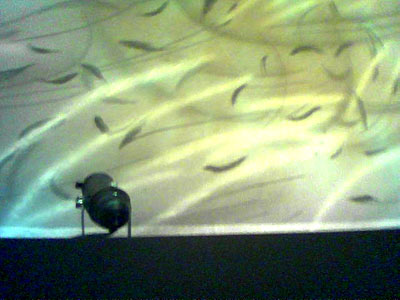
Let’s forget for a minute that I did part of my growing up in Denver and I had never heard of Sarah Breedlove (or Madame CJ Walker for that matter), who got her start in that city, until I visited Chicago’s DuSable Museum. There’s something wrong about a local history curriculum that overlooks the entrepreneur who pioneered the uniquely American business model that went on to influence outfits like Avon and Mary Kay.
Oh. Right. Black. And a woman. Can you blame the boys writing those books for thinking America’s first African-American Millionaire was invisible? (F*ckers.)
Let’s talk instead about the fact that I have a serious theatrical crush on the two women who held my attention last night in the Goodman Theatre’s production of Regina Taylor’s Dreams of Sarah Breedlove -- Ms L Scott Caldwell and Ms Cheryl Lynn Bruce.
These two have known each other and shared the stage since the 70s, and to watch them together is sheer joy. L Scott anchors the stage regardless of the scene she occupies – generous in all that she gives her colleagues, but careful never to shine so large that she puts her fellow players to shame. All the actors put on a good show last night – but when Ms Bruce took the stage with Ms Caldwell – well, we went somewhere entirely different, didn’t we?
That’s some chops.
Lucky for us they occupy the opening scene, so after you’ve witnessed that beautiful musical play back and forth between two friends, you’re hooked for the rest.
(I should mention here that Ms Bruce has become my indicator, like a red sky at dawn, for knowing how many tissues to pack. If she’s on the cast list – as she was for this show and for Mary Zimmerman’s Trojan Women -- the probability is high that the fluid output will be greater than the back of the hand can accommodate.)
The rest unwinds as a lovely narrative thread – nothing surprising or avant-garde about the storytelling – just solid and true, leaving you at last in a shuddering cathartic heap at the end as the final lines are spooned out.
One of the details that struck me last night was the way stagehands were used to change the scenes. In the opening act two silent players help to transition the set between scenes – we’ll meet them later in the second act – but tellingly in this first one, as they do their work, they engage (albeit silently) with the players who are transitioning to the next.
They weren’t invisible. Which was a point of some consequence.
I suspect litwit will have much to say about the inanity of the questions that come up in the Q&A session with some of the players and the artistic director (don’t let me down, girlfriend). And yes: it was just as bad she says. (update: permalink)
But even that couldn’t outshine what I took home last night: The feeling of a good cry and sense made out of the chaos – for just a brief little while.
God I love a good show.
Thursday, July 13, 2006
hot wax
This little guy was on display at the Field Museum in one of those machines that molds hot wax into pre-determined shapes -- for a small fee.
My sister and I went nuts on a road trip from Denver to Florida one summer when we were kids -- hitting my grandparents up for spare coins at every rest stop where they had one of these contraptions.
By the end of the trip we each had a killer whale, a dolphin, and a pirate, which, along with the US Flags on toothpicks that we took from our club sandwiches as Sambo's, we used to stage elaborate musical puppet shows in the backseat.
Much to my grandparents' dismay.
The smell of the hot wax still makes me giddy.
My sister and I went nuts on a road trip from Denver to Florida one summer when we were kids -- hitting my grandparents up for spare coins at every rest stop where they had one of these contraptions.
By the end of the trip we each had a killer whale, a dolphin, and a pirate, which, along with the US Flags on toothpicks that we took from our club sandwiches as Sambo's, we used to stage elaborate musical puppet shows in the backseat.
Much to my grandparents' dismay.
The smell of the hot wax still makes me giddy.
Wednesday, July 12, 2006
tut job
Disappointment presupposes high expectations. Knowing that, I’ve made a pact with myself not to care, not to want, and not to hope about anything having anything to do with Tut.
Because the hype has been too big, and the run is going to be too long (through January 1 at the Field Museum), and too many people who don’t care about desiccation on an ordinary day care are going nuts over this kid’s canopic jars.
As if.
But the Anthropology Alliance generally puts on a good show, so I had high hopes for last night’s private viewing of the King Tut exhibit.
The Anthro Alliance is a satellite group of Field Museum members who care about things anthropological. Recent past events have catered the geek in me: There was a viewing and lecture and book signing about some of the best remaining examples of Madagascar textiles (“remaining” because the museum housing the best burned down in Madagascar a few years ago, and took the textiles with it); and a presentation by Bob Martin regarding the paper he was getting ready to publish in Science on the Flores Man.
Besides: The food's always good, and the bar's usually open.
But last night was pretty tepid. Big crowd, meager spread, and a lecture that tried to cover way too much old ground (yep – thanks – picked up that bit about the cyclical flooding of the Nile in 5th grade world history – got anything fresh?).
The exhibit, on the other hand – the thing I was prepared to be unimpressed by – was pretty dang cool. Of course the pieces that grabbed me the most didn't show up in the catalog (at least in the little mini-catalog that was the only one I was interested in forking over the cash for) and my darlin’ companion was hovering close by and pointing to the “no photography” sign, so I came away without any pictures to show.
So you’ll have to believe me when I tell you that there are some pieces that really are worth seeing:
There’s a wonderful obsidian bust cracked down one side – the contrast of the glassy unfinished obsidian against the finished surface is alone worth the price of admission
A leather dog collar. Very cool. And very big. (For a big dog, apparently.)
A child’s seat with the woven reed seat still intact
The gold base of a fan that used to hold ostrich plumes (as a matter of fact ostrich are indigenous to Egypt, as we learned later that night [okay -- so the lecture wasn't a total wash]) – and if you peek into one of the holes where the plumes were mounted you can see where one busted off and left the nib behind
A beaten gold covered sarcophagus lid that on which bits of the linen shroud, soaked in resin, is still stuck to the gold (I love it when the organic stuff survives. I’ll take fibers and seeds over gold and silver any day.)
And the simple inlaid wreath that served Tut as a crown – the one he wore on his head under all those layers and layers and layers that they entombed him in
The crown is delicate and intricate and divine, and the expressiveness of the cobra and the vulture that peer out from the front of it had me ogling for much longer than was polite.
One of my favorite pieces of the show was a wooden carving of a symbol that I learned about for the first time last night – cousin to the Ankh, it was a Djed, and there seemed not only to be an importance to the number of bars that crossed it at the crown, but also the way it was colored – and maybe even the sequence of that coloration. With the dc keeping me honest I had to resort to sketching (in a hurry) a rough outline of what I saw:

In the same way the Ankh represents life, the Djed represents stability, and it appeared repeatedly in the pieces that peppered the show -- pulled, of course, from a period of turbulent history, emerging from the religious upheaval that Akhnaten wrought and trying desperately to set things right again.
The symbol usually showed up as an object that was clutched and held aloft -- almost as if a wooden staff, were it beautiful enough and crafted out of enough precious metals and semi-precious stones -- could possess the power to settle the upsurges of a violent world.
As if.
(But wouldn’t that be something if it could?)
Because the hype has been too big, and the run is going to be too long (through January 1 at the Field Museum), and too many people who don’t care about desiccation on an ordinary day care are going nuts over this kid’s canopic jars.
As if.
But the Anthropology Alliance generally puts on a good show, so I had high hopes for last night’s private viewing of the King Tut exhibit.
The Anthro Alliance is a satellite group of Field Museum members who care about things anthropological. Recent past events have catered the geek in me: There was a viewing and lecture and book signing about some of the best remaining examples of Madagascar textiles (“remaining” because the museum housing the best burned down in Madagascar a few years ago, and took the textiles with it); and a presentation by Bob Martin regarding the paper he was getting ready to publish in Science on the Flores Man.
Besides: The food's always good, and the bar's usually open.
But last night was pretty tepid. Big crowd, meager spread, and a lecture that tried to cover way too much old ground (yep – thanks – picked up that bit about the cyclical flooding of the Nile in 5th grade world history – got anything fresh?).
The exhibit, on the other hand – the thing I was prepared to be unimpressed by – was pretty dang cool. Of course the pieces that grabbed me the most didn't show up in the catalog (at least in the little mini-catalog that was the only one I was interested in forking over the cash for) and my darlin’ companion was hovering close by and pointing to the “no photography” sign, so I came away without any pictures to show.
So you’ll have to believe me when I tell you that there are some pieces that really are worth seeing:
The crown is delicate and intricate and divine, and the expressiveness of the cobra and the vulture that peer out from the front of it had me ogling for much longer than was polite.
One of my favorite pieces of the show was a wooden carving of a symbol that I learned about for the first time last night – cousin to the Ankh, it was a Djed, and there seemed not only to be an importance to the number of bars that crossed it at the crown, but also the way it was colored – and maybe even the sequence of that coloration. With the dc keeping me honest I had to resort to sketching (in a hurry) a rough outline of what I saw:

In the same way the Ankh represents life, the Djed represents stability, and it appeared repeatedly in the pieces that peppered the show -- pulled, of course, from a period of turbulent history, emerging from the religious upheaval that Akhnaten wrought and trying desperately to set things right again.
The symbol usually showed up as an object that was clutched and held aloft -- almost as if a wooden staff, were it beautiful enough and crafted out of enough precious metals and semi-precious stones -- could possess the power to settle the upsurges of a violent world.
As if.
(But wouldn’t that be something if it could?)
time to eat
I love Gaper’s Block for a lot of reasons –- their format is genius, and the daily weather report is every thing I need to get out the door in the morning (yesterday: Umbrella. One Layer. today: Muggy & Murky.).
Their RSS Merge feed feeds me sweet little nuggets of local info in readily digestible morsels. They just served up this little piece about a Mickey-D's billboard that went up in Wrigleyville. Say what you will about McDonald's -- it's a pretty friggin' cool billboard (the round of applause goes to Leo Burnett for the concept):

Their RSS Merge feed feeds me sweet little nuggets of local info in readily digestible morsels. They just served up this little piece about a Mickey-D's billboard that went up in Wrigleyville. Say what you will about McDonald's -- it's a pretty friggin' cool billboard (the round of applause goes to Leo Burnett for the concept):

To turn the sundial concept into reality, Leo Burnett hired Christian Huff, a Chicago-based electrical engineer and technical advisor to Studio One East, a Chicago graphic design business that does work for Leo Burnett.
Mr. Huff says he evaluated several available billboards before settling on the one west of Wrigley Field, where the sun hits at just the right angle to tell time between 6 a.m. and noon.
He then designed an aluminum set of McDonald’s arches measuring four feet by three-and-a-half feet to serve as the “dial” mounted above the billboard. “The underlying concept is simple, but the application is messy,” Mr. Huff says, explaining that he had to tweak the positioning of the arches so it would cast an undistorted shadow on the billboard at noon, when the arches fall on a sandwich, signaling lunchtime.
From «McD’s launches next strike in breakfast war – in Wrigleyville» in Crain's ChicagoBusiness
olympic spirit
I’ve held a deep distrust of the Olympics and the changes they bring to a city ever since I met a small business woman from Utah whose livelihood was threatened (and the quality of her neighborhood destroyed) almost immediately by the changes that came to Salt Lake City when they won the right to host the games in their city.
This morning’s story on the changes that are coming to Beijing in anticipation of the 2008 Olympics only feeds that distrust.
Isn’t it important, when building something, that the construction be appropriate to the native environment and can be put to good use for some future duration?
I’m not convinced that the new construction demanded by an Olympic venue is enduring construction. Sure, it’ll always be put to some kind of use (infamously, there was the soccer stadium in Sarajevo, used during the war as a burial ground) – but it’s one-shot wonder construction that serves a single event in history and then can do no better than to be appropriated for something else that it wasn’t necessarily intended to serve.
And to bulldoze a historic neighborhood – paying lifelong residents paltry sums before kicking them out on the street (one couple received $174K for property valued at $1.4 Million) to make way for crap construction, seems to me one of the worst kinds of property crimes you can commit.
London is one of my favorite cities in the world. I wasn’t one of the ones cheering when they won the bid.
The Gay Games are in Chicago this weekend – which is a good thing. But I heard someone mention on the news that this was the first step in proving that our city has the mettle to host the big shot Olympics. That we’re getting ourselves into position.
Please. God. No.
[Photo Credit: eyecatcher]
This morning’s story on the changes that are coming to Beijing in anticipation of the 2008 Olympics only feeds that distrust.
“Does this look like a scene from quaint Beijing or more like a war zone?” asked Pan Jinyu, 64, a local resident, as he stood on a narrow street pockmarked by flattened houses. Not far away, a red and white propaganda banner fluttered over a razed building: “Build a New Beijing and Welcome the Olympics.”My distrust stems from wildass theories about sustainability, I suppose....
“They are doing it in stages,” [Said Mike Meyer, an American who lives in the Old Beijing neighborhood and has written a book about it.] “It’s progressing like a wave cresting.” He said the gradual approach had left many residents elsewhere in the city unaware of the scope of the demolition. Comparing it to New York, he added, “It’s like one morning you woke up and Chelsea was gone.”
From «Olympics Imperil Historic Beijing Neighborhood» in this morning’s New York Times
Isn’t it important, when building something, that the construction be appropriate to the native environment and can be put to good use for some future duration?
I’m not convinced that the new construction demanded by an Olympic venue is enduring construction. Sure, it’ll always be put to some kind of use (infamously, there was the soccer stadium in Sarajevo, used during the war as a burial ground) – but it’s one-shot wonder construction that serves a single event in history and then can do no better than to be appropriated for something else that it wasn’t necessarily intended to serve.
And to bulldoze a historic neighborhood – paying lifelong residents paltry sums before kicking them out on the street (one couple received $174K for property valued at $1.4 Million) to make way for crap construction, seems to me one of the worst kinds of property crimes you can commit.
London is one of my favorite cities in the world. I wasn’t one of the ones cheering when they won the bid.
The Gay Games are in Chicago this weekend – which is a good thing. But I heard someone mention on the news that this was the first step in proving that our city has the mettle to host the big shot Olympics. That we’re getting ourselves into position.
Please. God. No.
[Photo Credit: eyecatcher]
Subscribe to:
Posts (Atom)
